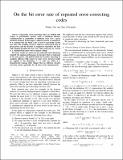On the bit error rate of repeated error-correcting codes
Author(s)
Weihao Gao; Polyanskiy, Yury
DownloadPolyanskiy_On the bit.pdf (292.6Kb)
OPEN_ACCESS_POLICY
Open Access Policy
Creative Commons Attribution-Noncommercial-Share Alike
Terms of use
Metadata
Show full item recordAbstract
Classically, error-correcting codes are studied with respect to performance metrics such as minimum distance (combinatorial) or probability of bit/block error over a given stochastic channel. In this paper, a different metric is considered. It is assumed that the block code is used to repeatedly encode user data. The resulting stream is subject to adversarial noise of given power, and the decoder is required to reproduce the data with minimal possible bit-error rate. This setup may be viewed as a combinatorial joint source-channel coding. Two basic results are shown for the achievable noise-distortion tradeoff: the optimal performance for decoders that are informed of the noise power, and global bounds for decoders operating in complete oblivion (with respect to noise level). General results are applied to the Hamming [7, 4, 3] code, for which it is demonstrated (among other things) that no oblivious decoder exist that attains optimality for all noise levels simultaneously.
Date issued
2014-03Department
Massachusetts Institute of Technology. Department of Electrical Engineering and Computer ScienceJournal
Proceedings of the 2014 48th Annual Conference on Information Sciences and Systems (CISS)
Publisher
Institute of Electrical and Electronics Engineers (IEEE)
Citation
Weihao Gao, and Yury Polyanskiy. “On the Bit Error Rate of Repeated Error-Correcting Codes.” 2014 48th Annual Conference on Information Sciences and Systems (CISS) (March 2014).
Version: Author's final manuscript
ISBN
978-1-4799-3001-2